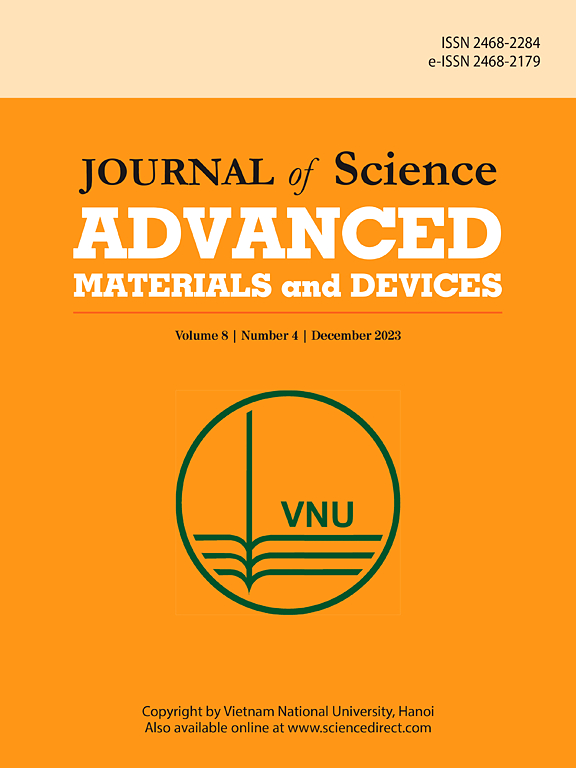Novel thermotropic system with UV-blocking ability for dynamic radiative cooling and synchronous visible/NIR tuning of windows in buildings in hot climate regions
IF 6.8
3区 材料科学
Q1 MATERIALS SCIENCE, MULTIDISCIPLINARY
Journal of Science: Advanced Materials and Devices
Pub Date : 2025-05-14
DOI:10.1016/j.jsamd.2025.100907
引用次数: 0
Abstract
Passive dynamic thermotropic (TT) radiative cooling (RC) windows aid net-zero energy buildings in smart cities by adjusting sunlight and solar heat in response to temperature variations, as they become opaque when temperatures rise, thereby using thermal radiation to dissipate heat into outer space. They are ideal for controlling solar heat gain and privacy. Here, we introduce a innovative eco-friendly TT layer with ultraviolet (UV)-shielding and RC ability composed of a sol-gel derived di-ureasil hybrid matrix doped with carbon dots (CDs) obtained from Agapanthus africanus leaves and variable contents of TT 1-butyl-3-methylimidazolium chloride ([BMIm]Cl) ionic liquid. The layers exhibit high transparency and thermal stability. The thermotropic devices (TTDs) assembled demonstrated, at the highest [BMIm]Cl concentration used, improved thermo-optical performance mediated by the surface plasmon resonance effect (SPRE), broad operational range (30–70 °C), and excellent cycling stability. Maximum transmittance variation (ΔT) values of 31/27 % at 555/1100 nm were achieved. This new class of TT layer represents a milestone in the development of smart RC materials for autonomous solar modulation windows.
一种新型的热致性系统,具有阻挡紫外线的能力,用于热气候地区建筑物的动态辐射冷却和同步可见光/近红外调节
被动动态热致性(TT)辐射冷却(RC)窗户通过根据温度变化调节阳光和太阳热量来帮助智能城市中的零能耗建筑,因为当温度升高时它们变得不透明,从而利用热辐射将热量散发到外层空间。它们是控制太阳热增益和隐私的理想选择。本文介绍了一种具有紫外线屏蔽和RC能力的创新型环保TT层,该层由溶胶-凝胶衍生的双脲醛杂化基质和不同含量的TT 1-丁基-3-甲基咪唑氯离子液体组成,其中碳点(cd)掺杂从非洲加蓬叶中提取的碳点(cd)。该层具有高透明度和热稳定性。所组装的热致性器件(TTDs)表明,在使用的最高[BMIm]Cl浓度下,由表面等离子体共振效应(SPRE)调节的热光学性能得到改善,工作范围宽(30-70°C),循环稳定性好。在555/1100 nm处,最大透射率变化(ΔT)值为31/ 27%。这种新型的TT层代表了自主太阳能调制窗智能RC材料发展的一个里程碑。
本文章由计算机程序翻译,如有差异,请以英文原文为准。
求助全文
约1分钟内获得全文
求助全文
来源期刊

Journal of Science: Advanced Materials and Devices
Materials Science-Electronic, Optical and Magnetic Materials
CiteScore
11.90
自引率
2.50%
发文量
88
审稿时长
47 days
期刊介绍:
In 1985, the Journal of Science was founded as a platform for publishing national and international research papers across various disciplines, including natural sciences, technology, social sciences, and humanities. Over the years, the journal has experienced remarkable growth in terms of quality, size, and scope. Today, it encompasses a diverse range of publications dedicated to academic research.
Considering the rapid expansion of materials science, we are pleased to introduce the Journal of Science: Advanced Materials and Devices. This new addition to our journal series offers researchers an exciting opportunity to publish their work on all aspects of materials science and technology within the esteemed Journal of Science.
With this development, we aim to revolutionize the way research in materials science is expressed and organized, further strengthening our commitment to promoting outstanding research across various scientific and technological fields.
 求助内容:
求助内容: 应助结果提醒方式:
应助结果提醒方式:


